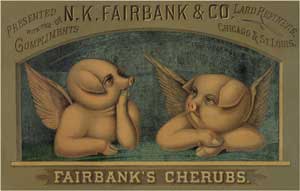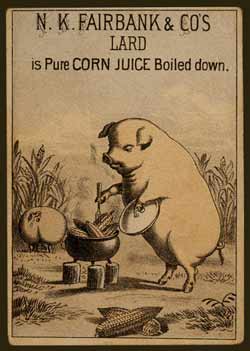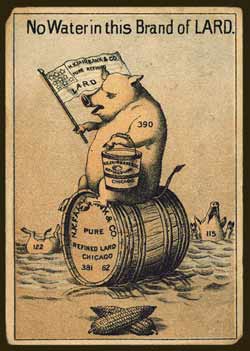trade card advertising in the late 19th century U.S.

The Porkopolis Art Museum recently added some examples of late nineteenth century advertising trade cards to its collection. These cards, advertising lard and featuring pigs, were created for the N.K. Fairbank Co. as advertisements for their household lard products.
The addition of these trade cards to the museum seemed like a good opportunity for a brief overview of the time period and the industry that spawned these ads. This is Part 1, which discusses the trade cards, and soon to follow will be Part 2, an overview of the origination of the term “Lord of Lard” and public mistrust of commercial lard products in the late 19th and early 20th century
In the United States in the 1870s, the rapid growth in manufacturing necessitated the need to extend current markets and build new ones. The proliferation of manufacturer advertising through out the later half of the nineteenth century, of which trade cards were only a part, had the aim of securing a share of the country’s growing consumer markets. New and current products needed to be branded and then market placement needed to be secured and maintained.
Origins and Growth of Trade Cards

Trade cards began in the seventeenth century as a somewhat formal announcement of the existence of a merchant’s store, the type of trade done and the location. By the late nineteenth century, trade cards had become a highly functional form of business advertisement that was popular with consumers and performed several important functions for manufacturers and retailers.
First, the cards informed and reinforced to consumers the various brand names, reputations and purchase locations of products. Secondly, they were effective when retailers wished to inform their customer base or when consumers wished to pass on to family members and friends the news of a terrific product – hand them a trade card.
And finally, as finer quality, colorful and entertaining cards were produced, the popularity of trade cards as a collectable further assured the permeation of the associated brand names out into the marketplace.
The Success of the N.K. Fairbank Brand Advertising
The trade cards on exhibit here in the Porkopolis.org Art Museum are examples of the art of persuasion favored by the advertising planners at N. K. Fairbank & Co. who successfully used the technique of a long series of pig-themed trade cards in advertising their lard products.

They correctly understood that in new and growing markets, advertisers must often artificially create a status for a marketed product and also imply a need on the part of the consumer for that particular product.
These trade cards are examples of the particular type of mid-eighteenth century advertising intended to suggest quality and build brand awareness. They were very effective in both convincing consumers to switch from local/homegrown lard to a suggested higher quality manufactured lard product, and in enhancing the company’s reputation, positioning the “N.K. Fairbank” brand as the best consumer choice.
Additional Information
Here are some additional sources of information pertaining to lard, advertising and trade cards:
- Trade Card from Wikipedia, the free encyclopedia.
- Rendering Lard 2.0 – Derrick Schneider of An Obsession with Food & Wine Gives instructions on how to render your own lard and then use it with reckless abandon.
- Emergence of Advertising in America – over 2,800 advertising items and publications dating from 1850 to 1920, illustrating the rise of consumer culture and the birth of a professional advertising industry in the United States.
- Productive Advertising by Herbert W. Hess published in 1915
- Poster Advertising by G.H.E. Hawkins, (the Advertising Manager of the N. K. Fairbank Co.) published in 1910.
- The Trade Card Place and articles about trade cards.
